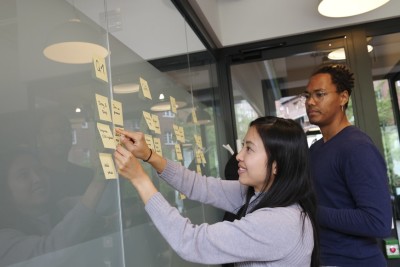
In product management, the journey from ideation to launch requires a sense of direction. Companies start with a vision on how they want to change the world they live in, then build a strategy to conquer the problems that block the company from the current state to get to the vision ahead of it. Both of these artifacts are helpful, but by design, they are big picture.
Vision is something that takes 3-5 years to accomplish, strategy - 6 -18 months. This is where Objectives and Key Results (OKRs) emerge as a guiding light, illuminating the path towards success.
Product design has unique needs, focused on delivering usable clear infrastructure and information to the customer and the user, and they need to have OKR’s that support that, all the while making sure that the strategy and vision are adhered to.
In this article, we get into the concept of OKRs for product design, emphasizing their significance in setting clear goals, fostering alignment, and achieving measurable outcomes. By reading it, you are going to get better at OKRs. We will talk about how to set meaningful objectives and key results, leveraging OKR’s for organization alignment, and how design can structure and communicate these objectives within the frame of strategy and vision.

What is an OKR?
Objective and Key Results (OKRs) focus on driving tactical change over the course of a quarter. They interface with the vision and strategy to help teams decide what to work on. That decision is important - OKRs are tools for empowered teams that aren’t being micromanaged. Teams that have a roadmap that is defined and locked in over a long period of time will find teams frustrated, as the tension between communicating projects that are set in stone over products that are always in motion create overhead that can muddle the strategy and vision upstream.
Defining meaningful objectives
At the heart of effective product design lies the art of setting meaningful Objectives. These Objectives act as beacons, guiding product design teams towards a common purpose. A well-crafted Objective encapsulates the 'what' and 'why' of a project, anchoring the team's efforts in a shared vision.
Defining a meaningful objective starts at with the strategy. The strategy you are leveraging should answer the question “what is the big problem we need to solve?” If you have the answer to that question, think about what a milestone that will get you closer, thats achievable in the next three months.
This isn’t easy, and will take a few times to get right. The key is to not get too frustrated, and realize that good OKRs can take a few quarters to nail down. The important thing is you are thinking about them in the right way.
Here is a way to judge your OKRs:
Can a person, without you being in the room, determine what they need to work on next based on your objective? Can they use that “beacon” as a way to ask a relevant question to get over a misunderstanding? Can the objective help prioritize the next step, or at the very least, get the team together to figure out what that is during regular syncs?

Selecting key results for measurable outcomes
Pairing alongside Objectives are Key Results, the tangible and measurable outcomes that signify progress. Good key results is how you measure objectives.
Ask yourself, how will you know your objective will be achieved? What will be a meaningful improvement to tell the story of your objective? For product design, do you have a way to measure UI and UX improvement? If not - think of this article as a wake up call.
Much like objectives, this will take time to get right, don’t get discouraged and constantly experiment.
It's hard to overlook the role of airfocus, a platform that empowers product managers to align their Key Results with their Objectives seamlessly. This alignment is crucial, as it fuels the engine of progress, fostering a direct correlation between efforts and results. By enabling teams to quantify success, airfocus strengthens the foundation of data-driven decisions.
Product design and the rest of the team
Product designers focus on making sure that the product is usable for customers, generally through the user interface(UI), user experience(UX), and the information architecture(IA) that the user is absorbing. The OKRs have to play nicely with the other functions you’ll work closest with - product managers and product engineers.
Product managers are often the interface between the business and the product team. As a product designer, they are great sources of information to learn more about how business strategy and the product strategy should steer the objectives you have in front of you. If you have to work with an objective they set - think about how your UI, UX, and IA can work with the key results to find alignment with the objective.
Product engineers are your building partners, and usually, there tends to be more of them. As a designer, they are great sources of information to learn more about how feasible current projects are, and where the architecture needs love. They usually are great partners when it comes to measuring, and can help you get the information you need when you are measuring your own KR’s. If they set the objective, like the PM, think about how your UI, UX, and IA work can help move the objective forward.

Evaluating success and driving improvement
In product design, the story doesn't end with achieving OKRs, it evolves through evaluation and continuous improvement. The digital era has bestowed upon us a treasure trove of performance metrics. Airfocus.com, with its data-driven prowess, transforms these metrics into actionable insights. Sources like Forbes emphasize the importance of leveraging data for informed decision-making, citing that data-driven organizations are 23 times more likely to acquire customers. This data-driven approach underpins the success of OKRs, enabling product design teams to pivot, refine, and innovate with precision.
Clarity comes with limits
Now that you have an idea of how to work with other teams, and what good OKRs could look like, let’s talk about clarity.
The biggest mistake teams make with OKRs is making too many of them. If our goal is alignment, for every item we add to our strategic toolkit, we take our focus away from the overall picture.
Many articles talk about cascading OKRs as a way to create alignment, which seems to make sense, however, it dismisses the fact that as human beings, we can take in limited information. By adding more we take ourselves out of the big picture, and soon what was a tool for alignment becomes a checklist.
If you find OKRs always “finishing” at the same time and nesting perfectly, you have a checklist OKR culture. Want a quick way to check this out? Ask five people on your team what’s the most important thing they should work on - if you get atleast three different answers, you have a checklist culture. If you can, scale back and make some choices.
In product design, OKRs act as a compass guiding teams towards their aspirations. airfocus' integration into this narrative amplifies this power, transforming it into a force that drives innovation, alignment, and achievement. As product managers plan the course ahead, they do so armed with a strong toolkit, one that marries vision with precision. Success, when targeted with Objectives and Key Results, resonates across organizations, industries, and time.

Adam Thomas

Read also






Create effective product strategy

Experience the new way of doing product management



